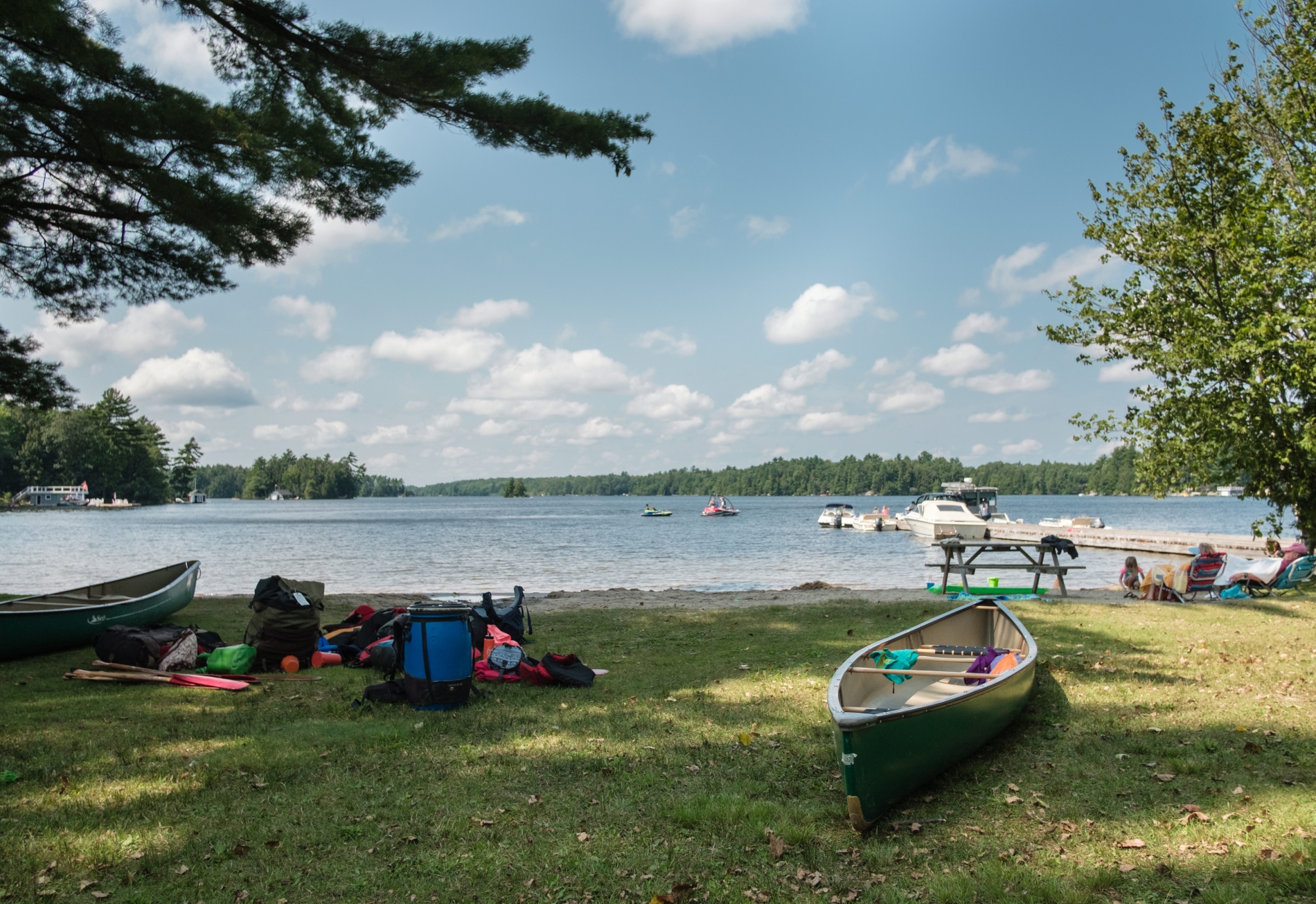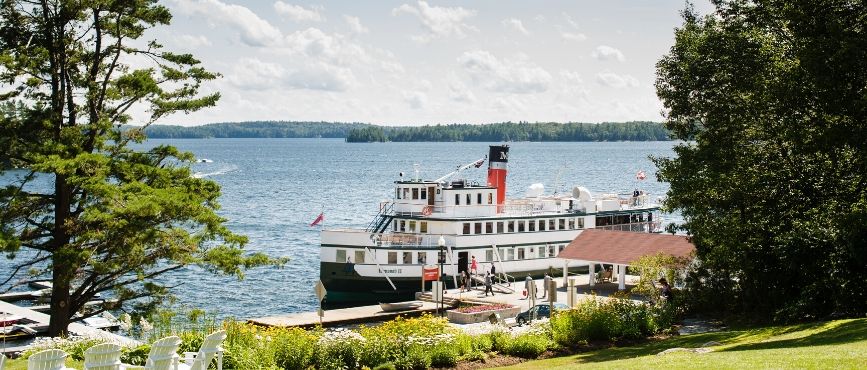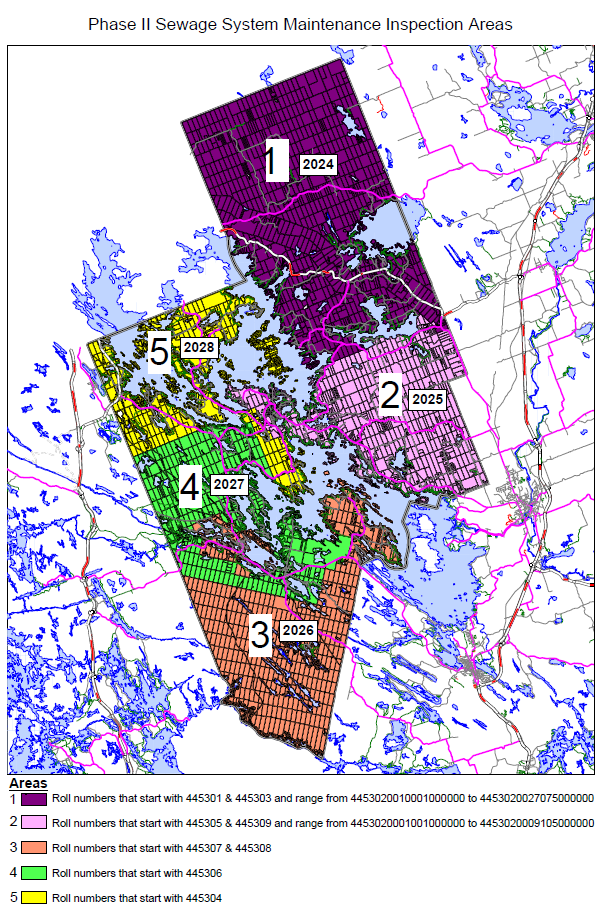
Septic Inspection Program

Sewage System Re-inspection Program
The Township has operated a septic re-inspection program since 2000. In 2006, the province changed the Building Code Act and the Ontario Building Code to enable Municipalities to undertake Discretionary Sewage System Maintenance Inspections.
The purpose of the Re-inspection Program is to inspect existing (Class I- Class V) on-site sewage systems, as defined by the Ontario Building Code (OBC), in order to identify maintenance concerns as defined under Section 8.9 of the OBC. On‐Site Sewage System Maintenance Inspections have been implemented by the Township of Muskoka Lakes as part of an environmental/safety initiative and in accordance with the amended Ontario Building Code (O. Reg. 315/10). The Township of Muskoka Lakes is committed to the preservation and enhancement of the water quality of our lakes and groundwater.
We have been working at categorizing over 10,000 sewage systems in the Township based on the below parameters:
Low Risk |
|
Not on waterfront or less than 10 years of age are not on our inspection schedule at this time. |
Moderate Risk |
| Waterfront, 10-30 years of age require a Phase I inspection conducted by Township staff. No appointment is required. |
High Risk |
|
Waterfront, +30 years of age or no permit found will require a more invasive inspection. Stay tuned for how to book your HIGH RISK system inspection. A fee will apply. |
Lakes where a water quality indicator has been confirmed will be prioritized and categorized accordingly.
To learn more, please read the Sewage System Maintenance Inspection Policy.
The Township is hosting a Public Information Session on May 13th, 2025, to provide information about Phase II Sewage System Maintenance Inspections occurring in the summer of 2025 for the south-east area of the municipality. The Information Session will be recorded, and a recording will be posted on the website. To watch a replay of last year's information session, visit our YouTube Channel.
At the commencement of each inspection season, a Public Information Session will be held.
Inspection Areas
The Township has been divided into 5 areas. Inspection schedules are being created for the year 2024 and subsequent years. See the below map and policy for more information:

Frequently Asked Questions
| How much will it cost for EnVision Consultants Ltd. to inspect a sewage system on my property? |
|
Fees associated with the Sewage System Maintenance Inspection Program have been approved by Township Council under Fees and Charges Fees and Charges By-Law 2025-035 . Costs for EnVision Consultants Ltd. to complete sewage systems inspections are as follows: Phase II inspection where previous permit approval record is available * - $335.00 Phase II inspection where NO previous permit approval record is available * - $350.00 Post Remedial inspection required * - $205.00 No access/not ready for inspection * - $225.00 * all invoices are subject to a $25 administrative fee Additionally, properties where a third-party inspector has been retained beyond the April 11th deadline will incur an additional charge of $225.00 due to insufficient notice provided to the Township. Therefore, please submit necessary information in a timely manner. Similarly, properties that do not engage in the sewage system inspection program in the 2025 season will be assessed a $225.00 fee (+administrative fee & taxes) and required to comply with the program in the following year. Property owners not compliant with the program requirements may also be subject to charges under the Administrative Monetary Penalty System (AMPS) Bylaw. |
|
How do I prepare for my inspection? |
| Owners are required to uncover (unbury) tank lids, which includes tanks such as septic tanks, pump tanks and distribution boxes. Relevant system paperwork should also be gathered such as the most recent pump out receipt. |
| Do I need to be present at time of the inspection? |
| No, you do not have to be present, but it is recommended that you or someone over the age of 18 is present to act on your behalf. This will help you understand the observations that are made during the inspection and how your system is operating. |
| What is included as part of a Phase II Maintenance Inspection? |
| Sewage system components, such as septic tanks, pumping tanks, distribution boxes and leaching beds, will be documented for construction and condition. Other information collected during the inspection will include dwelling information that relates to the sewage system, such as the number of bedrooms, and water supply source(s). Additional requirements include flow testing the system and may include soil sampling. |
| When will the sewage system maintenance inspections occur? |
|
Inspections will be occurring between May and October. There will be a secondary letter sent if the services of a third party inspector are not obtained from EnVision outlining the date, time, cost and how to prepare. |
| My sewage system shows no visible signs of failing and there is no odour, why do I need to have it inspected? |
| The Township of Muskoka Lakes has developed a Risk Classification system for sewage systems which dictates the type of inspection required as well as the frequency in which the system is to be inspected. The full details can be found in the Township’s Sewage System Maintenance Inspection Policy.
Sewage Systems classified as “High Risk” include any sewage system:
|
Sewage System Maintenance Tips
| Dos and Don’ts of Flushing |
| Toilet paper and human waste only! Avoid harsh chemicals, bleaches, degreasers, septic system additives, oils, greases, solids, and pharmaceuticals. |
| Vegetation Around your Sewage System |
|
A properly functioning leaching bed must have appropriate vegetative cover to allow for evaporation, transpiration, compaction prevention, and optimal treatment of wastewater. One of the most common issues our re-inspection team comes across is inappropriate vegetation on and around the system. Deep-rooted vegetation such as trees and berry bushes can and will grow into the leaching bed pipes causing system failure. We recommend a minimum distance of 6 meters from the pipes in the bed to woody plants. For very shallow-rooted trees such as poplar, maple, willow, elm and sumac we recommend a more extreme distance of 15 metres from tree to pipe. Appropriate shallow-rooted vegetative cover over a leaching bed includes grasses & native wildflower mixes. It is important that the vegetation planted is drought tolerant as the leaching bed area should not be irrigated as to not overload the system. |
| Effluent Filter Maintenance |
|
Since 2007, a device called an ‘effluent filter’ has been a requirement with every new septic tank installation. The effluent filter is attached to the outlet pipe within the liquid side of the septic tank. This device is a great addition to the system as it can prolong the life of your leaching bed by filtering out solids (ie. corn kernels) and small particles (ie. fuzz from your favourite fleece sweater) before clogging pipes and soil pores. The effluent filter requires regular maintenance – we recommend having it checked and cleaned at a minimum of once per year. As an added bonus, the bacterial life that establishes on the surface of the filter acts as additional biological treatment of the wastewater before it makes its way into the natural environment! |
| Pumping Schedule |
|
Septic Tanks are divided into a solids and liquids compartment. The first compartment of the tank is for the solids. The solids settle to the bottom of the tank forming a sludge, while greases and fats float to form a scum layer. According to the Ontario Building Code, the tank must be pumped whenever the scum and sludge occupy one third of the tank. It is important to pump the septic tank at this stage to ensure the solids do not build up and make their way into the leaching bed; this can lead to clogging of the pipes and even system failure. It is important to note that there is such a thing as pumping the septic tank too frequently. If the tank is consistently pumped before bacteria has a chance to establish and find its equilibrium in the tank, the sewage can become sterile. Sterile sewage is essentially ‘dead’ and not properly treated before it makes its way into the leaching bed and environment. It is crucial to create a customized pumping schedule with your sewage hauler that suits your usage. For example, a system that is used seasonally by two people will not need to be on the same pumping schedule as four-season usage by a family of 5. There are many licensed sewage haulers in the Muskoka Lakes area that are full of knowledge. |
| Signs of System Failure |
|
There are over 100 ways an onsite sewage system can malfunction. The signs to look out for include: sewage backup into the house, sluggish drainage of plumbing fixtures, sewage surfacing in the yard, and/or sewage odours. If any of these problems occur, call a professional to troubleshoot the issue. The solutions range from the replacement of a pump, to a blocked effluent filter, to a leaching bed replacement. According to the Ontario Onsite Wastewater Association, septic systems and can last for upwards of 20 years. As leaching beds are not made to last forever, if your sewage system is reaching 20 years of age, you should begin to save and prepare for a replacement system. In Muskoka, many systems get a break and are only used seasonally. We also have access to quality granite-based sands and stone – note that this may prolong the life of some systems in our area. |
| Drainage Diversion |
|
Directing surface water and stormwater away from your septic system is imperative for a properly functioning system. The systems depend on dry unsaturated soils to treat the wastewater within and around the leaching bed. Quite often when a leaching bed is not fully mounded up; drainage swales, French drains, or ditches are created upslope of the bed to keep the system as dry as possible. These water diversion methods are often enforced at the time of the installation as part of the septic system construction inspection. An issue our re-inspection team runs into are newly constructed driveways or landscape alterations which direct water towards the sewage system, instead of away from the area. Be mindful of this when planning your projects. The above reasons are why it is also a requirement that eavestroughs be directed away from the system and why the leaching bed should never be irrigated. |
| Useful Resources |
Contact Us


 Subscribe to this Page
Subscribe to this Page